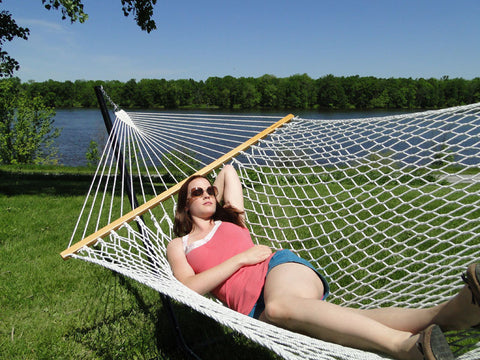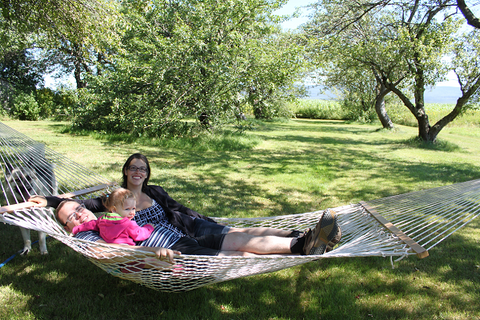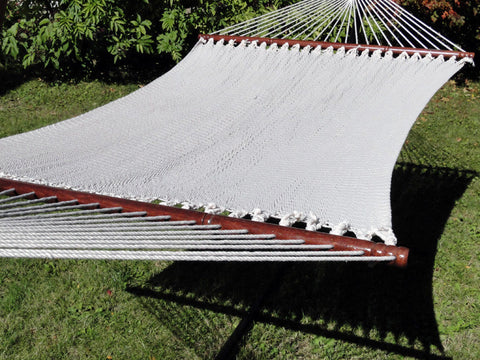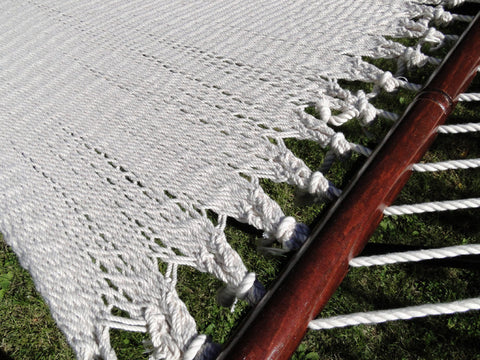Rope Hammocks
[Short-Desc]
Traditional, simple, and comfortable.
Even though rope hammocks have been around for over 100 years, they are still almost completely unmatched in terms of sheer usefulness for the everyday buyer. They offer all the versatility you can need, able to be transported just about anywhere — while still providing a solid level of support. And, unlike their “poolside” counterparts, they won’t roll you up like a burrito.
[Long-Desc]
Where did the Rope Hammock Come From?
Like all great inventions, rope hammocks were created to solve a problem. Captain Joshua John Ward, a riverboat captain from South Carolina, needed a cheap, quick, and efficient way to help his crew sleep on the boat without lugging around heavy bed frames and mattresses. Even though hammocks had been around for more than a thousand years by this point, most of these styles were complex to create and, even worse for a business owner, expensive to boot.
But Cap’n Josh — as he was known — had another problem. Since most of these hammocks would be used while the men were at sea, they needed to use readily available supplies to make repairs, if necessary. Since rope has been on just about every ship that has ever set sail, the captain knew he had a solution.
By creating the rope hammock, Cap’n Josh was able to solve several problems all at once: Create a sleeping solution that was portable, comfortable, and could withstand the constant rocking of a boat. Thanks to the weave-like design of rope hammocks that allowed the fibers to pull against each other and create a tight sleeping structure, the rope hammock was an instant hit.
Why is it Called a Rope Hammock?
Rope hammocks got their name from the cotton or polyester ropes that form the hammock itself. Each material has its own unique advantage: cotton is usually regarded as more comfortable, while polyester is generally more durable. If you’re planning on keeping yours in storage, however, or use it primarily inside, a cotton rope hammock can last you 20 years or more.
Since ropes aren’t very rigid — nor should they be, for comfort’s sake — they usually need a spreader bar at the top and bottom to make sure they maintain a flat surface for laying on. These bars are typically made from metal or wood but may even be able to be replaced if one of them is damaged.
Are There Different Types of Rope Hammocks?
Generally speaking, there are two different styles of rope hammocks that you may encounter. The first is the Mayan hammock, which has a tight, diamond-shaped pattern that creates a tight weave in the netting. These types of hammocks are usually the most comfortable type of rope hammock you can buy since they’re made out of exceptionally soft cotton and lightly woven together, increasing their flexibility. We also sell hammock chairs.
The other type of rope hammock is the Nicaraguan hammock. Though these can also be comfortable, they also use a double-weave pattern and use heavier cotton than other styles, which makes them thicker and heavier. Many people feel that this delivers a more luxurious feeling, but others may find it cumbersome. Ultimately, it all boils down to individual preference.
Can More Than One Person Use a Rope Hammock?
Depending on your use, you may be looking at purchasing a rope hammock for solo adventures or family usage. Those who use their rope hammocks on the back porch, for instance, may enjoy loading up their entire family on a single hammock while they watch a movie.
While this may seem picturesque, you should always be careful to check the load limit before you buy. Usually, hammocks that are built for single occupancy hover around the 300-pound mark, while those for double occupancy go up to 450 pounds or more. Unless you have a rope hammock custom-made, it’s best to stay under that weight limit so as to prevent injury.
Part of the reason for these limits is in the design of the hammock itself. In order to create a comfortable experience, the cotton fibers have to be the right consistency; usually, this isn’t achieved with heavier and denser fabrics. Additionally, where you decide to hang the hammock also matters. Metal stands that are engineered for a specific weight limit will snap or bend if more weight is put on top of it. Bolting it to a tree won’t necessarily help either, since the bolts — or the tree — could collapse under the weight.
If you have any questions about the limits of a hammock, feel free to ask! Our team is more than ready to answer any concerns you may have regarding your specific usage.
What are the Advantages and Disadvantages of a Rope Hammock?
Having a rope hammock in your yard is akin to creating your own personal oasis. It’s built directly for comfort, which means installing one is a gateway to direct comfort and relaxation.
That being said, there are certain downsides. If you live in a colder climate, for instance, the fabric in the netting can become brittle and snap, especially if it’s left outside for any length of time. If it rains, you may also notice mold and mildew start to appear on the fabric as well, which necessitates a replacement.
Other people simply don’t like the feeling of the weave against their body since it can leave indentations on your skin — though these are almost always minor. The spreader bar across the top and bottom can also make it more cumbersome to wrap up and transport, though you’ll find some version of these bars on just about every hammock you find.
On the other hand, rope hammocks offer a number of different advantages that other hammocks simply can’t match. They’re much more affordable, comparatively speaking, and require almost no maintenance apart from leaving them out to air dry. They breathe and “give” when weight is put on them, which means they’re incredibly flexible and are absolutely perfect for warm weather. Few things are more relaxing on a nice summer day than laying in your hammock listening to the birds.
What Kind of Accessories Do I Need?
Most of the hammocks that we sell come standard with all the accessories you need to get going and can be installed in a matter of minutes. The ropes and spreader bar come rolled up, allowing you to find your relaxation spot soon after it arrives on your front porch.
But if you want to add to your hammock’s versatility, we recommend looking at other stands and bolts that you can buy to hang it in various places. We’ve seen people hang their rope hammocks in between trees, on a beach, or even on their boat — just like Cap’n Josh used to do. While you may not need the stand all the time, having it certainly helps you enjoy your rope hammock in more locations. Other than a few pillows and maybe a blanket, you shouldn’t need anything else to enjoy your hammock correctly.
Ready to Relax?
Whether you’re in the market for a hammock for you or looking for that perfect gift to give a special someone, we’ve got you covered. Our line of rope hammocks are customer-tested and approved, and we would love to bring our signature look to your front porch.
Our hammocks are made from the finest weather-proofing materials around them, which means they won’t break down if you happen to leave it outside during a rainstorm. They’re also easy to use, easy to maintain and come in a variety of different colors and styles. We guarantee you’ll find the look for you!
Not ready to buy just yet? Don’t worry, keep an eye out on our website for special deals and promotions. We’re always looking to give our customers the best deal possible, so stay in touch! Regardless, we look forward to giving you a little slice of heaven with our signature line of rope hammocks.




